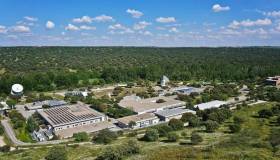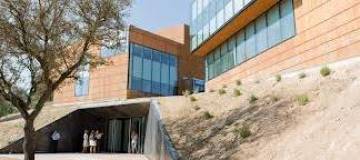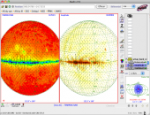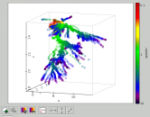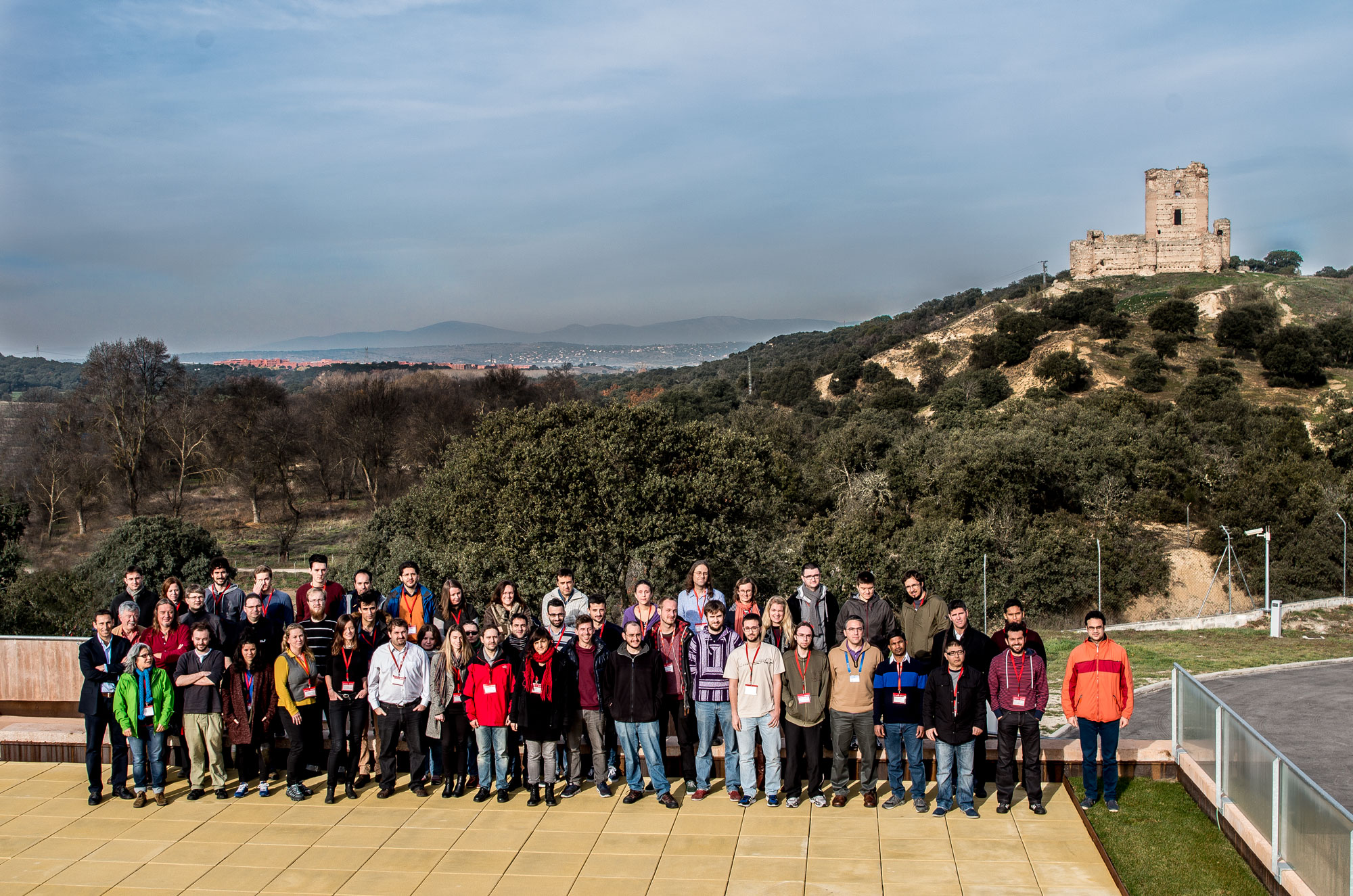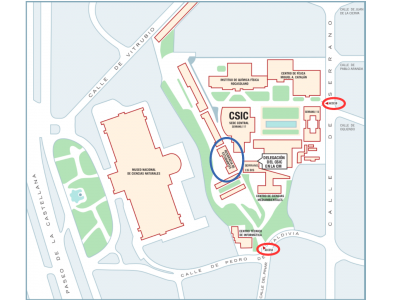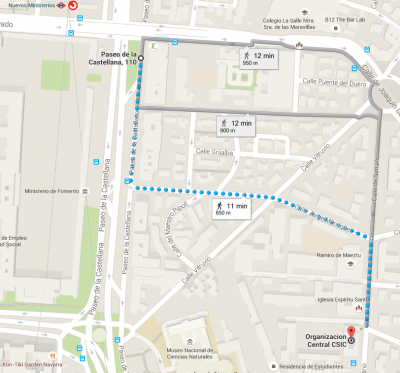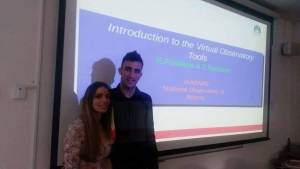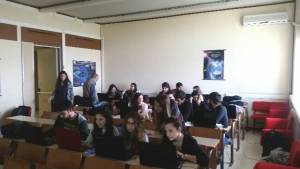Table of Contents
First ASTERICS School
More photos at: https://www.smugmug.com/gallery/n-wwjzCD/i-CgWms5X
The ASTERICS project is organising an international Virtual Observatory school at the Centro de Astrobiología, Madrid, Spain.
The Virtual Observatory (VO) is opening up new ways of exploiting the huge amount of data provided by the ever-growing number of ground-based and space facilities, as well as by computer simulations. The goal of the school is twofold:
- Expose European astronomers and representatives of the ESFRI projects involved in ASTERICS to the variety of VO tools and services available today so that they can use them efficiently for their own research.
- Gather requirements and feedback from participants.
To achieve these goals, VO experts will lecture and tutor the participants on the usage of VO tools and services. Real life examples of scientific applications will be given. A large fraction of the time will be dedicated to hands-on exercises, which will allow participants to become fully familiar with the VO capabilities on their own laptops.
In order to ensure the right level of interaction, participation will be restricted to a limited number of participants (45 approx.). Preference will be given to PhD students and post-docs.
Dates
- First announcement: 16 October 2015
- Deadline for submission of participants' use cases: 20 November 2015 New date
- Deadline for registration: 20 November 2015 New date
- Meeting: 15-17 December, 2015
Location
Centro de Astrobiología (CAB, INTA-CSIC) Campus ESAC 28691 Villanueva de la Cañada Madrid, Spain
The campus is located about 30 km north-west of Madrid.The meeting will take place in the conference centre of ESAC, in building D, rooms D1/D2. The location of the conference centre and of other facilities on the ESAC site can be found in this map.
Registration
The registration form can be accessed here
Accomodation
A block booking of 30 rooms has been made at the Residencia de Estudiantes on 14-18 December at a special rate.
- Single room: €65.96 per night (including tax). If more than 15 rooms are occupied, then, the price would be 57.42 euros.
- Breakfast (optional): €7.20 per person per day (including tax).
- Dinner (optional): €14.30 per person per day (including tax).
All rooms are equipped with free wifi.
To make the reservation, send an email to: reservas@residencia.csic.es (with copy to esm@cab.inta-csic.es) indicating:
- Name and surname
- Institution
- Position
- Check-in and check-out dates
- Reference: First ASTERICS VO School
The Residencia de Estudiantes is located at the headquarters of the Spanish National Research Council (CSIC). There are two entrances, one (the main gate) at Serrano, 117 and another one at the intersection of Pedro de Valdivia and Pinar (see map in the Transportation section). From 22:00h to 07:00 the entrance Pedro de Valdivia/Pinar is locked. If you arrive later you will have to ring the bell and identify yourself saying that you are staying at the Residencia de Estudiantes.
More information about the Residencia de Estudiantes can be found in this flyer: staying_at_the_residencia.pdf
Program
A preliminary program can be found here
Transportation
There will be buses available to transport participants from the hotel to ESAC in the mornings and back in the afternoons.Buses will departure from the intersection of Pedro de Valdivia and Pinar (see map below).
IMPORTANT: There will be no passenger control, which means the bus will not wait for you. Please, try to be in place at least 5 minutes in advance. ESAC is in the middle of the countryside and difficult to reach by public transport. So, if you miss the bus, you'll get in trouble… Information on how to reach ESAC from the Residencia de Estudiantes by taxi can be found here
- From the airport to Residencia de Estudiantes.
- By taxi:
- Taxis from the airport to the Residencia de Estudiantes (and from the Residencia to the airport) have a fixed price of €30. Estimated duration of the journey: 20 to 25 minutes (depending on traffic conditions). The official Madrid taxi is white with a red diagonal stripe across the front door. The destination to tell the taxi driver is: “Consejo Superior de Investigaciones Científicas. Calle Serrano, 117”
- By metro:
- From all Terminals at Madrid Barajas - Adolfo Suárez airport (T1, T2, T3 and T4): line #8 (pink) to Nuevos Ministerios. Estimated duration of the journey (25 minutes from Terminal 4. 20 minutes from Terminals 1,2,3). Take exit “Pº de la Castellana, pares”. The CSIC headquarters is at a walking distance (10-12 minutes, see map below).
- A map of the metro can be found here. Metro opening hours: From 06:00h to 01:30h.
- A one-way ticket costs €4.5 (includes the €3 airport supplement).
- You can buy tickets at the ticket counters and ticket machines in the lobby of any Metro station.
Click on the maps for a larger size.
Financial support
Travel and accommodation support is available for the participants in this workshop. For further information, contact esm@cab.inta-csic.es
Other links of interest
You can find useful information about Madrid in these web sites:
You can see the weather forecast here.
Organisation
Local Organising Committee: Enrique Solano, Francisco Jiménez, Carlos Rodrigo
Contact: esm (at) cab (dot) inta-csic (dot) es
School follow-up
- Report on the questionnnaire sent to participants one year after the school (November 2016)questionnaire1year_firstschool-1.pdf
- Seminar at the National Observatory of Athens
- Speakers: Ektoras Pouliasis & Zoi Spetsieri
- Duration: Three hours
- Date: March 2016
- Participants: 10 people (PhD students, Post-docs & Seniors)
- Scope: The seminar was focused on the advanced tutorials of TopCat and Aladin, making as well a general presentation about the other VO tools.
- Seminar at the University of Athens
- Speakers: Ektoras Pouliasis & Zoi Spetsieri
- Duration: Six hours
- Date: March 2016
- Participants: 25 people (15 undergraduate + 10 Master students)
- Scope: Introduce participants in the VO world and show them the capabilities of the VO tools. In particular, we went through the tutorials of TopCat, Aladin, CDS (ViZier+Simbad) and also those of VOSpec, Splat-Vo and VOSA.
- General conclusion of both seminars: The response of all participants was really positive to all the VO tools and they were excited to use them in their own projects, mainly the undergraduate students.
- A couple of pictures of the seminars are give below
- Workshop on VO standards and tools at Krakow Observatory
- Workshop Web page: http://www.g-vo.org/pmwiki/VOWorkshop/VODayCrakow2016
- Speakers: Hendrik Heinl
- Duration: Two days
- Date: April 26th-27th 2016
- Participants: 25 people (from Bachelor to postdoc level).
- Scope: This course provides a basic introduction to the Virtual Observatory. The focus will be on access and analysis of table data, images and spectra. Participants will learn how to use Virtual Observatory tools like Topcat, Aladin, Splat and ADQL in hands-on sessions.
- General conclusions
- Reinforcement of links with Krakow observatory, in particular regarding the data publication in the VO.
- Strong interest of several participants in attending the next ASTERICS VO school to be held in Strasbourg by the end of the year.
- Presentation in the Second Cosmology School. Kielce (Poland)
- Workshop Web page: http://www.cosmology-school.ujk.edu.pl/
- Speakers: Hendrik Heinl
- Duration: Two days
- Date: July 16th-17th 2016
- Participants: 56 people
- Scope: The general purpose of the Second Cosmology School in Kielce is to give an introduction to the current knowledge in cosmology, both in theory and observations. This School is intended for undergraduate, MSc and PhD students, as well as young postdoctoral researchers, interested in these fields.
The program of the school will include mini-workshops on: - cosmological simulations - Virtual Observatory database and tools - SED fitting.
* VO science cases presented during the Heraeus Summer School
- Workshop Web page: http://www.arcetri.astro.it/heraeus2016/programme.html
- Speakers: Mirko Curti, Giacomo Venturi
- Duration: One week
- Date: August 23th-30th 2016
- Participants: 78 people.
- Scope: The aim of the Heraeus project is to create, foster, and maintain a network of University and high school teachers, and to develop materials and methods on present day research in astronomy and astrophysics to be used in high schools.
- Tutorials presented:
- Determination of stellar physical parameters using VOSA: The Collinder 69 open cluster
- Discovery of Brown Dwarfs mining the 2MASS and SDSS databases with ALADIN
- Presentations can be found at: http://www.arcetri.astro.it/heraeus2016/PDF/VO_tutorial.pdf
* VO mini-workshop in the framework of the Third Cosmology School (Cracow, Poland)
- Workshop Web page: http://cosmoschool2017.oa.uj.edu.pl/
- Organizers: Małgorzata (Goha) Bankowicz, Agnieszka Kurcz, Aleksander Herzig, Magdalena Krupa
- VO speakers: Hendrik Heinl, Jenny Sorce.
- Date: July 15th-16th 2017
- Participants: 73 people.
- Tutorials presented:
- Introduction to VO tools
- An introduction to the CDS services and tools
- Introduction to ADQL

